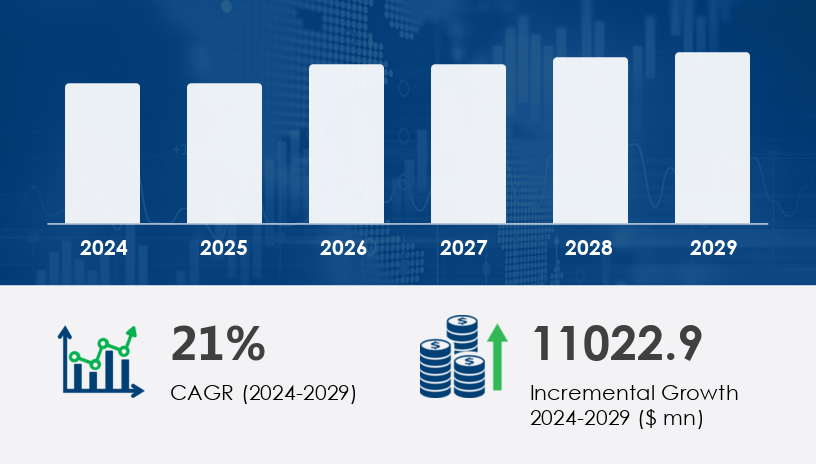Online Grocery Market India Trends and Forecast 2025-2029
The online grocery market in india is projected to expand by USD 11.02 billion from 2025 to 2029, progressing at a CAGR of 21%. This growth is driven by the rising adoption of e-commerce platforms, the convenience of online shopping, and increasing consumer preference for digital payment solutions. However, challenges such as last-mile delivery inefficiencies, packaging concerns, and maintaining the freshness of perishable goods continue to impact market growth. The industry is also witnessing trends such as increased demand for functional foods and beverages, real-time order fulfillment, and the rise of quick commerce models.

For more details about the industry, get the PDF sample report for free
Market Segmentation
By Product
- Food Products: Includes fresh produce, dairy, grains, dry fruits, baking goods, and ready-to-eat meals.
- Non-Food Products: Includes personal care, household essentials, and pet care items.
By Type
- Online Payment: Digital transactions are gaining traction due to enhanced security and convenience.
- Cash on Delivery: Continues to be a preferred payment method, particularly in rural and semi-urban areas.
By Platform
- Website: Traditional e-commerce platforms with diverse product listings.
- Mobile: Apps providing personalized shopping experiences and quick transactions.
Regional Market
- India: The only region covered in this study, experiencing rapid digitalization and urbanization, leading to increased online grocery adoption.
Market Dynamics
Drivers
- Expansion of E-Commerce Platforms: The surge in digital platforms and food-delivery services is fueling online grocery sales. Consumers now have access to a wide range of products, from fresh produce to household essentials.
- Growing Urbanization and Smartphone Penetration: Increased digital adoption has enabled businesses to cater to the urban consumer base effectively.
- Convenience and Time-Saving Benefits: Online grocery shopping offers flexibility, scheduled deliveries, and price comparisons, making it an attractive option for busy consumers.
- Diverse Product Offerings: Availability of fresh food grains, dairy, personal care items, beverages, and specialty products is boosting demand.
Trends
- Rise of Functional Foods and Beverages: Increasing consumer awareness about health and wellness is driving demand for antioxidant-rich foods, low-fat options, and specialty beverages.
- Quick Commerce and Subscription Models: Companies are leveraging real-time delivery services and membership programs to enhance customer retention.
- Advancements in E-Commerce Technology: Mobile apps, secure payment gateways, and AI-driven shopping experiences are shaping the future of online grocery shopping.
Challenges
- Maintaining Freshness of Perishable Items: Ensuring product quality and reducing transit delays remain key obstacles for online grocers.
- Logistical and Supply Chain Constraints: The need for efficient last-mile delivery solutions and storage facilities poses a challenge.
- Consumer Trust and Security Concerns: Reliable payment gateways and return policies are critical to building confidence in online grocery platforms.
Get more details by ordering the complete report
Key Market Players
The competitive landscape of India’s online grocery market includes prominent players investing in strategic partnerships, geographical expansion, and technological innovation. Key players mentioned in the market research abstract include:
- Amazon.com Inc.
- Avenue Supermarts Ltd.
- B L Agro Industries Ltd.
- Blink Commerce Pvt. Ltd.
- Brisam Retail Pvt. Ltd.
- Dookan Technologies s.r.o
- Dunzo Digital Pvt. Ltd.
- Flipkart Internet Pvt. Ltd.
- Flora Foods
- FRESHTOHOME FOODS Pvt. Ltd.
- GFOI Retail Pvt. Ltd.
- Heritage Foods Ltd.
- Innovative Retail Concepts Pvt. Ltd.
- JioMart
- One97 Communications Ltd.
- Satvika Bio Foods India Pvt. Ltd.
- SPAR Group Inc.
- Spencers
- Zepto
Future Market Insights
The India online grocery market is poised for sustained expansion, fueled by the increasing reliance on digital shopping platforms, evolving consumer preferences, and advancements in e-commerce technology. As urbanization continues and online payment adoption rises, businesses will need to optimize logistics and delivery infrastructure to maintain a competitive edge. The emergence of AI-driven personalization, quick commerce, and subscription-based shopping models is expected to redefine the online grocery experience, ensuring long-term growth and innovation in the sector.